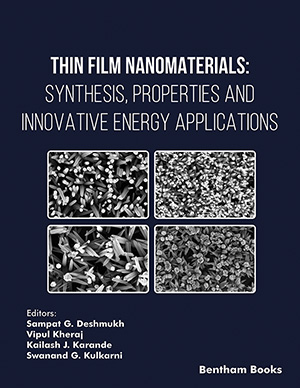
Abstract
Carbon nanotubes are synthesized by Low Pressure Chemical Vapor Deposition (LPCVD) system using NH3: C2H2:H2 gas mixtures on iron coated silicon substrate. The iron catalyst was coated on silicon using RF-sputtering method. The growth temperature was kept at 600 °C and growth time was 10 mins. The carbon nanotubes are found to have diameters ranging from 50 to 80 nm and length of up to a few tens of microns. Raman spectra indicate that the CNTs are highly graphitized and several peaks are also found at low frequency range from 100 cm-1 to 500 cm-1 , which are assigned to the radial breathing mode (RBM) which is the characteristic of single wall carbon nanotubes. Therefore, this sample also contains single walled carbon nanotubes also. The carbon nanotubes showed a turn-on field of 2.63 V/μm and the maximum current density of 2 mA/cm2. The field enhancement factor was calculated to be 3.941 X 103 for as grown carbon nanotubes. The carbon nanotubes grown at this lower temperature show good field emission and are suitable for device applications.
Keywords: Field Emission, Low Pressure Chemical Vapor Deposition, Multi-walled carbon nanotubes, Raman Spectroscopy, SEM, Nanoparticles, magnetic materials, MWCNTs, nanotoxicity, cell displacement, neuronal differentiation
Current Nanoscience
Title: Characterization and Field Emission Studies of Uniformly Distributed Multi-Walled Carbon Nanotubes (MWCNTs) Film Grown by Low-pressure Chemical Vapour Deposition (LPCVD)
Volume: 7 Issue: 3
Author(s): Javid Ali, Avshish Kumar, Samina Husain, Monika Kumari, Harsh and Mushahid Husain
Affiliation:
Keywords: Field Emission, Low Pressure Chemical Vapor Deposition, Multi-walled carbon nanotubes, Raman Spectroscopy, SEM, Nanoparticles, magnetic materials, MWCNTs, nanotoxicity, cell displacement, neuronal differentiation
Abstract: Carbon nanotubes are synthesized by Low Pressure Chemical Vapor Deposition (LPCVD) system using NH3: C2H2:H2 gas mixtures on iron coated silicon substrate. The iron catalyst was coated on silicon using RF-sputtering method. The growth temperature was kept at 600 °C and growth time was 10 mins. The carbon nanotubes are found to have diameters ranging from 50 to 80 nm and length of up to a few tens of microns. Raman spectra indicate that the CNTs are highly graphitized and several peaks are also found at low frequency range from 100 cm-1 to 500 cm-1 , which are assigned to the radial breathing mode (RBM) which is the characteristic of single wall carbon nanotubes. Therefore, this sample also contains single walled carbon nanotubes also. The carbon nanotubes showed a turn-on field of 2.63 V/μm and the maximum current density of 2 mA/cm2. The field enhancement factor was calculated to be 3.941 X 103 for as grown carbon nanotubes. The carbon nanotubes grown at this lower temperature show good field emission and are suitable for device applications.
Export Options
About this article
Cite this article as:
Ali Javid, Kumar Avshish, Husain Samina, Kumari Monika, Harsh and Husain Mushahid, Characterization and Field Emission Studies of Uniformly Distributed Multi-Walled Carbon Nanotubes (MWCNTs) Film Grown by Low-pressure Chemical Vapour Deposition (LPCVD), Current Nanoscience 2011; 7 (3) . https://dx.doi.org/10.2174/157341311795542525
| DOI https://dx.doi.org/10.2174/157341311795542525 |
Print ISSN 1573-4137 |
| Publisher Name Bentham Science Publisher |
Online ISSN 1875-6786 |
Call for Papers in Thematic Issues
Advanced Inorganic Nanocomposites and their Emerging Applications
This special issue will highlight developments in the recent trends in the synthesis of metal oxides, nanoclusters, biomaterials, 2D nanomaterials, nanocrystals, nanocomposites, etc., and their applications in electrochemical systems, tissue regeneration, energy storage and harvesting, sensors, etc. The novelty of the methods in the chemical synthesis, as well as their ...read more
Advanced Nanotechnology in Forensic Science: Revolutionizing Fingerprint Identification and Crime Scene Analysis
This special issue aims to provide a comprehensive exploration of the innovative fusion between nanotechnology and forensic science. It aspires to bridge the gap between traditional investigative techniques and cutting-edge nanoscale applications, envisioning a paradigm shift in forensic analysis. By compiling the expertise of multidisciplinary experts, the book's objectives include ...read more
Graphene and 2D Materials for Energy Storage and Conversion.
This thematic issue will discuss the recent advances in graphene-based nanomaterials for different energy technologies. Graphene possesses a high surface area, and stable structure and exhibits many interesting electronic, optical, and mechanical properties due to its 2D crystal structure. Graphene is of both fundamental interest and suitable for a wide ...read more
Nanopathology; A Promising Approach for Targeted Cancer Treatment
Cancer is the most challenging diseases in treatment worldwide. Recently, the nanotechnology opened the gate for targeting the cancer as a promising therapy. The small size and exceptional properties of nanoparticles give it several advantages for easily targeting of cancerous cells. Furthermore, this advantage allows them to easily penetrate deeply ...read more
Related Journals
 4
4
- Author Guidelines
- Graphical Abstracts
- Fabricating and Stating False Information
- Research Misconduct
- Post Publication Discussions and Corrections
- Publishing Ethics and Rectitude
- Increase Visibility of Your Article
- Archiving Policies
- Peer Review Workflow
- Order Your Article Before Print
- Promote Your Article
- Manuscript Transfer Facility
- Editorial Policies
- Allegations from Whistleblowers






















